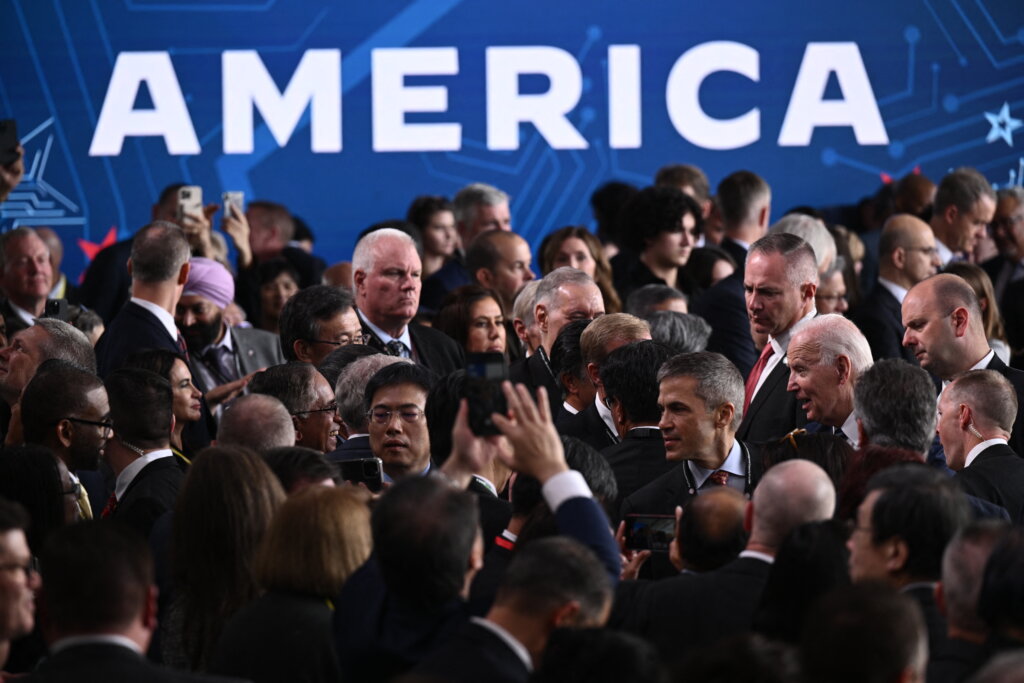US aims for chip supremacy: From zero to 20% by 2030

- The US wants to regain its leadership within the chip industry, and Commerce Sec. Raimondo targets 20% domestic production of leading-edge chips by 2030.
- The US currently produces none; hence, the ambitious goal is set for the end of this decade.
- Biden admin aims to bring memory chip production to the US “at scale.”
As the global demand for semiconductors surges, the US has embarked on a bold mission to revitalize its chip manufacturing industry. Last February, the Commerce Department launched the CHIPS for America program, echoing the ambitious spirit of the space race era. While US companies lead in AI development, the absence of domestic chip production poses a critical challenge. However, with a strategic focus on talent development, R&D, and manufacturing, the US aims to fill this gap and produce 20% of the world’s leading-edge chips by 2030.
Commerce Secretary Gina Raimondo remains optimistic about the program’s potential to transform America’s industrial landscape. The US aims to fortify its supply chains and reduce reliance on geopolitical rivals by investing in leading-edge logic chip manufacturing and onshoring memory production. “Our investments in leading-edge logic chip manufacturing will put this country on track to produce roughly 20% of the world’s leading-edge logic chips by the end of the decade,” Commerce Secretary Gina Raimondo said during a speech at the Center for Strategic and International Studies (CSIS) on February 26, 2024.
“That’s a big deal,” Raimondo added. “Why is that a big deal? Because folks, today we’re at zero.” Her speech came a year after the initiation of funding applications under the 2022 CHIPS and Science Act by the US Department of Commerce. With a staggering US$39 billion earmarked for manufacturing incentives, the stage has been set for a transformative journey in the semiconductor landscape.

US Commerce Secretary Gina Raimondo speaks during the UK Artificial Intelligence (AI) Safety Summit at Bletchley Park. (Photo by TOBY MELVILLE/POOL/AFP).
Raimondo’s ambitious vision, unveiled concurrently, delineates the path ahead. By 2030, the US aims to spearhead the design and manufacture of cutting-edge chips, establishing dedicated fabrication plant clusters to realize this audacious objective. She claims that, besides everything else, there has been a significant shift in the need for advanced semiconductor chips due to AI.
“When we started this, generative AI wasn’t even part of our vocabulary. Now, it’s everywhere. Training a single large language model takes tens of thousands of leading-edge semiconductor chips. The truth is that AI will be the defining technology of our generation. You can’t lead in AI if you don’t lead in making leading-edge chips. And so our work in implementing the CHIPS Act became much more important,” Raimondo emphasized.
If the US achieves its goals, it will result in “hundreds of thousands of good-paying jobs,” Raimondo said Monday. “The truth of it is the US does lead, right? We do lead. We lead in the design of chips and the development of large AI language models. But we don’t manufacture or package any leading-edge chips that we need to fuel AI and our innovation ecosystem, including chips necessary for national defense. We don’t make it in America, and the brutal fact is the US cannot lead the world as a technology and innovation leader on such a shaky foundation,” she iterated.
Why is there a gap between US and chip manufacturing?
The US grappled with a significant gap in chip manufacturing for several reasons. Firstly, many semiconductor companies outsourced their manufacturing operations overseas to cut costs, leading to a decline in domestic chip production capacity. Secondly, as semiconductor technology advanced, the complexity and cost of building cutting-edge fabrication facilities increased, discouraging investment in new fabs.
Meanwhile, global competitors like Taiwan, South Korea, and China expanded their semiconductor industries rapidly, intensifying competition. While other countries provided substantial government support to their semiconductor industries, the US fell behind. Then, there were regulatory hurdles, and environmental regulations make building and operating semiconductor fabs in the US challenging and costly.
A combination of outsourcing, technological challenges, global competition, lack of government support, and regulatory issues contributed to the US’s gap in chip manufacturing, with none of the world’s leading-edge chips being produced domestically.
And then the world woke up one morning in dire need of leading-edge chips to underscore the technology behind the next industrial revolution, and America realized its mistake.
“We need to make these chips in America. We need more talent development in America. We need more research and development in America and just a lot more manufacturing at scale,” Raimondo said in her speech at CSIS.
2030 vision: prioritizing future-ready projects

US President Joe Biden greets attendees at a TSMC chip manufacturing facility. (Photo by Brendan SMIALOWSKI/AFP).
In Raimondo’s speech, she declared that the US will first prioritize projects that will be operational by the end of this decade. “I want to be clear: there are many worthy proposals that we’ve received with plans to come online after 2030, and we’re saying no, for now, to those projects because we want to maximize our impact in this decade,” she clarified.
In short, the US will give way to “excellent projects that could come online this year” instead of granting incentives to projects that will come online in 10 or 12 years from now. She also referred back to the goal mentioned last year – when the US is all said and done with this CHIPS initiative – is to have at least two new large-scale clusters of leading-edge logic fabs, each of those clusters employing thousands of workers.
“I’m pleased to tell you today we expect to exceed that target,” she claimed. So far, the Commerce Department has awarded grants to three companies in the chip industry as part of the CHIPS Act: BAE Systems, Microchip Technology, and, most recently, a significant US$1.5 billion grant to GlobalFoundries. Additional funding is anticipated for Taiwan Semiconductor Manufacturing Co. and Samsung Electronics as they establish new facilities within the US.
Raimondo also highlighted her nation’s commitment to supporting the production of older-generation chips, referred to as mature-node or legacy chips. “We’re not losing sight of the importance of current generation and mature node chips, which you all know are essential for cars, medical devices, defense systems, and critical infrastructure.”
Yet, the lion’s share of investments, totaling US$28 billion out of US$39 billion, is earmarked for leading-edge chips. Raimondo emphasized that this program aims for targeted investments rather than scattering funds wisely. She disclosed that the department has received over US$70 billion in requests from leading-edge companies alone.
For now, anticipation is high for the Commerce Department’s new round of grant announcements, scheduled to coincide with President Joe Biden’s State of the Union address on March 7. Among the expected recipients is TSMC, which is establishing new Arizona facilities.









